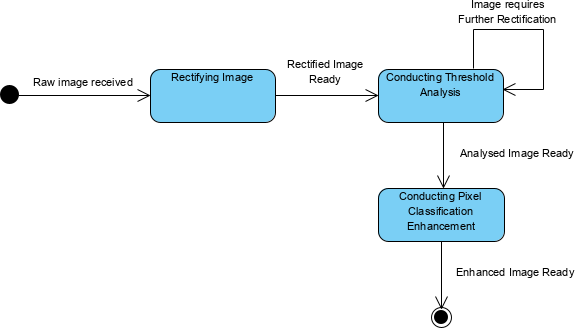The SV-10b is a graphical method of describing a resource’s response to various events in terms of its changes of state. The view specifies the possible states a resource can be in, the possible transitions between those states, and the triggers for those changes.
The functional specification of a resources behaviour presented in SV-4, Functionality Description, can show the flows of control and data between resources, but it cannot reflect the changes of state that occur when control or data is passed from one resource to another. SV-10b provides this additional information.
Usage
The intended usage of the SV-10b includes:
- Definition of states, events and state transitions (behavioural modelling).
- Identification of constraints on possible states (input to System Requirements Document).
Product Description
The SV-10b relates events to resource states and describes the transition from one state to another. SV-10b describes state transitions from a resource perspective, with a focus on how the resource responds to stimuli (e.g. triggers and events). As with the OV-6b, Operational State Transition Description, these responses may differ depending upon the rule set or conditions that apply as well as the resource’s state at the time the stimuli is received.
Composing state transitions provides a model of states known as a state chart.
The SV-10b relates states, events, and actions. A state and its associated action(s) specify the response of a resource or function to events. When an event occurs, the next state may vary depending on the current state (and its associated action), the event and the rule set or guard conditions. A change of state is called a transition. Each transition specifies the response based on a specific event and the current state. Actions may be associated with a given state or with the transition between states.
States in SV-10b products may be nested. This enables quite complex models to be created to represent resource behaviour.
Creating a Resource State Transition Description diagram
To create a Resource State Transition Description diagram:
- Click on Resource State Transition Description in the Action Artifact area, and then select Create New Diagram.
- You are creating a table for managing the state diagrams. Type a name for the table. You can create multiple tables based on different contexts (e.g. by phases, purposes, etc).
- This opens a table where you can create and manage state diagrams. Click on New Resource States Definition above the table to create a new row.
- Under the first column, select the context to create state diagram, which can be a ResourceArchitecture, System, CapabilityConfiguration, Organization, Person, Post, Responsibility, Project, NaturalResource, ResourceArtifact, Software or Technology.
- Under the second column, create the state diagram(s). The diagram created will be added to the selected context element as a sub-diagram.

MODAF in Visual Paradigm
The MODAF is brought to you by Visual Paradigm, a full-featured development platform. Visual Paradigm provides an easy-to-use, model-driven MODAF tool that supports the development of MODAF views and models. You can create integrated MODAF products and generate architectural documents that facilitate organizations to efficiently coordinate enterprise architecture initiatives.